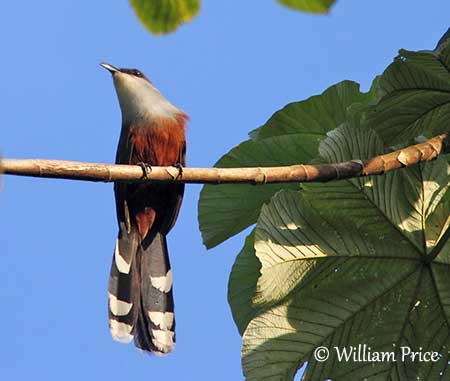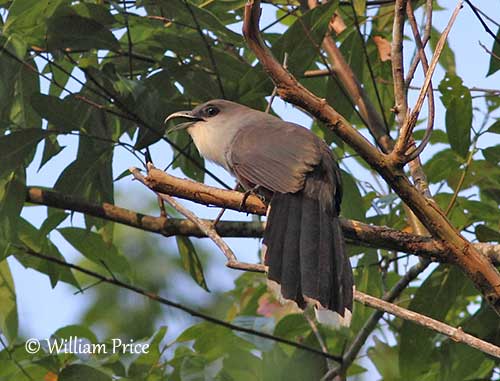
Fr: Piaye de pluie - Tacco de pluie
Ang: Chestnut-bellied Cuckoo
All: Regenkuckuck
Esp: Cuco Picogordo de Jamaica
Ita: Cuculo panciacastana
Nd: Regenkoekoek
Sd: jamaicaregngök
Photographers:
William Price
PBase-tereksandpiper & Flickr William Price
Dubi Shapiro
Dubi Shapiro Photo Galleries & Dubi Shapiro's Pictures on IBC
Text by Nicole Bouglouan
Sources:
HANDBOOK OF THE BIRDS OF THE WORLD vol 4 by Josep del Hoyo-Andrew Elliott-Jordi Sargatal - Lynx Edicions - ISBN: 8487334229
BIRDS OF THE WEST INDIES – by Herbert Raffaele, Kristin Williams et Tracy Pedersen – Helm – ISBN: 9780713649055
Cuckoos of the World Par Johannes Erritzøe, Clive F. Mann, Frederik Brammer, Richard A. Fuller – Editeurs A&C Black, 2012 – ISBN: 1408142678, 9781408142677
Avibase (Denis Lepage)
Neotropical Birds – Cornell Lab of Ornithology
Chestnut-bellied Cuckoo
Coccyzus pluvialis
Cuculiformes Order – Cuculidae Family
INTRODUCTION:
The Chestnut-bellied Cuckoo is endemic to Jamaica where it frequents wet open forests at mid-elevations. It is usually more often heard than seen!
It feeds on insects, lizards, small rodents, bird chicks and eggs. This species is not a brood-parasitic cuckoo, and it builds its own nest, a shallow cup in tree.
The Chestnut-bellied Cuckoo has currently stable population, and the species is not globally threatened.
DESCRIPTION OF THE BIRD:
Biometrics:
Length: 48-56 cm
Weight: 130-189 g
The Chestnut-bellied Cuckoo has dull brown upperparts including the wings. The long, graduated tail is black with purple gloss and broad white tips.

On the underparts, the chin is whitish whereas throat and breast are pale grey. Belly and undertail-coverts are dark chestnut, giving the bird its English name. From below, the tail appears barred white when closed.
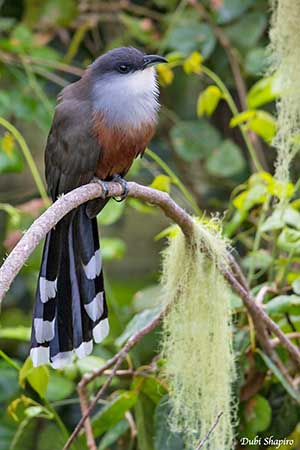
On the head, the crown is dark grey-brown but the lower face is whitish.
The thick, decurved bill is blackish with bluish-grey tinge. The eyes are red to brown, with blackish orbital skin. Legs and feet are bluish-grey or dark grey.
Male and female are similar.
The juvenile resembles adult, but it has dark brown tail with white tips.
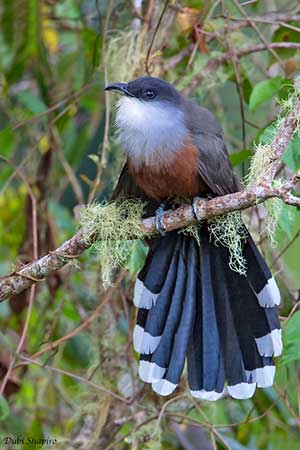
RANGE:
The Chestnut-bellied Cuckoo is found in Jamaica. It is common in mountain forests.
HABITAT:
The Chestnut-bellied Cuckoo occurs in tropical lowland evergreen forest, in open woodlands, in dense second growths and in gardens. It is visible between 400 and 1,500 metres of elevation, usually in wet forests.
CALLS AND SONGS: SOUNDS BY XENO-CANTO
The Chestnut-bellied Cuckoo has deep voice. It gives a hoarse, throaty “quawk-quawk-ak-ak-ak-ak-ak” starting slowly and accelerating towards the end. We can also hear a resonant, low “gwaauu” rising and then falling in pitch, and also a soft “qua”.
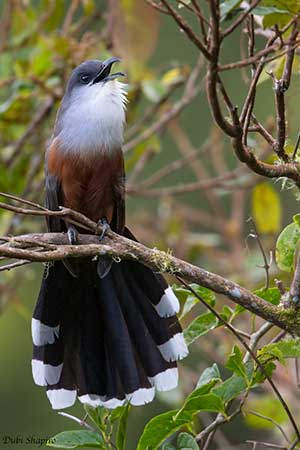
BEHAVIOUR IN THE WILD:
The Chestnut-bellied Cuckoo feeds primarily on large insects and their larvae, often burrowing insects found beneath the bark. It also takes lizards, small rodents (mice), bird chicks and eggs.
It forages at mid-level and in canopy, sometimes running along tree limbs and flying from tree to tree. It moves slowly through the forest.
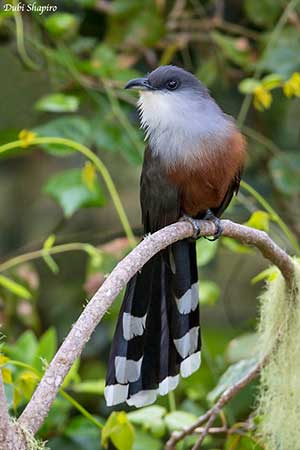
The Chestnut-bellied Cuckoo is not a brood-parasite. It nests in a shallow cup in bush or tree.
We can suggest that the bold pattern of white tail spots is important during the displays, when the birds spread and raise their long tails.
The Chestnut-bellied Cuckoo is resident in Jamaica, but it performs some altitudinal movements to lower elevations in winter.
It glides on extended wings from tree to tree when foraging.
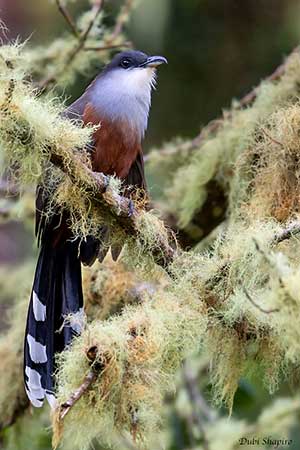
REPRODUCTION OF THIS SPECIES:
The breeding season occurs between March and June.
The Chestnut-bellied Cuckoo builds a shallow cup with twigs, placed in bush or tree, up to 10 metres above the ground.
The female lays 2-4 white eggs.
In the genus Coccyzus in the subfamily Coccyzinae, incubation and feeding duties are usually shared by both parents. In all species, the incubation lasts 10-11 days and begins with the first egg. The young fledge between 8 and 13 days after hatching.
PROTECTION / THREATS / STATUS:
The Chestnut-bellied Cuckoo is described as uncommon and has restricted range.
However, the population appears stable and the species is not globally threatened.
The Chestnut-bellied Cuckoo is currently evaluated as Least Concern.
